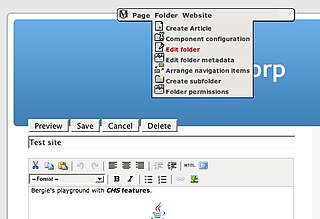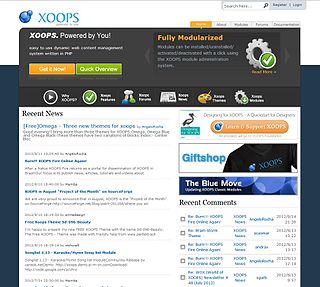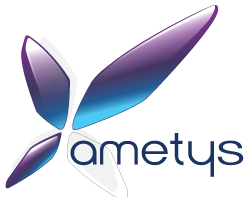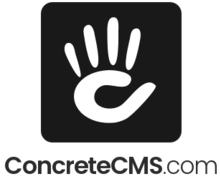
Drupal is a free and open-source web content management system (CMS) written in PHP and distributed under the GNU General Public License. Drupal provides an open-source back-end framework for at least 14% of the top 10,000 websites worldwide and 1.2% of the top 10 million websites—ranging from personal blogs to corporate, political, and government sites. Systems also use Drupal for knowledge management and for business collaboration.

Plone is a free and open source content management system (CMS) built on top of the Zope application server. Plone is positioned as an enterprise CMS and is commonly used for intranets and as part of the web presence of large organizations. High-profile public sector users include the U.S. Federal Bureau of Investigation, Brazilian Government, United Nations, City of Bern (Switzerland), New South Wales Government (Australia), and European Environment Agency. Plone's proponents cite its security track record and its accessibility as reasons to choose Plone.

Midgard is an open source persistent storage framework. It provides an object-oriented and replicated environment for building data-intensive applications.

OpenCms is an open-source content management system written in Java. It is distributed by Alkacon Software under the LGPL license. OpenCms requires a JSP Servlet container such as Apache Tomcat.

WebGUI is an open-source content management system written in Perl and released under the GNU General Public License.

XOOPS is a free open-source content management system (CMS), written in PHP. It uses a modular architecture allowing users to customize, update and theme their websites. XOOPS is released under the terms of the GNU General Public License (GPL) and is free to use, modify and redistribute.
The following tables compare general and technical information for a number of wiki software packages.
A web content management system is a software content management system (CMS) specifically for web content. It provides website authoring, collaboration, and administration tools that help users with little knowledge of web programming languages or markup languages create and manage website content. A WCMS provides the foundation for collaboration, providing users the ability to manage documents and output for multiple author editing and participation. Most systems use a content repository or a database to store page content, metadata, and other information assets the system needs.

DNN Platform is a web content management system and web application framework based on the .NET Framework. It is open source and part of the .Net Foundation.

Silverstripe CMS is a free and open source content management system (CMS) and framework for creating and maintaining websites and web applications. It provides an out of the box web-based administration panel that enables users to make modifications to parts of the website, which includes a WYSIWYG website editor. The core of the software is Silverstripe Framework, a PHP Web application framework.

MODX is an open source content management system and web application framework for publishing content on the World Wide Web and intranets. MODX is licensed under the GPL, is written in the PHP programming language, and supports MySQL, MariaDB and Percona Server as the database. It was awarded Packt Publishing's Most Promising Open Source Content Management System in 2007.

MoinMoin is a wiki engine implemented in Python, initially based on the PikiPiki wiki engine. Its name is a play on the North German greeting Moin, repeated as in WikiWiki. The MoinMoin code is licensed under the GNU General Public License v2, or any later version.

C1 CMS is a free open source .NET-based web content management system.
papaya CMS is an open-source content management system, free of charge and complying with open standards like XML as data format, XSLT as templating language, and PHP for programming.

Refinery CMS, often shortened to Refinery, is a free and open-source content management system written in Ruby as a Ruby on Rails web application with jQuery used as the JavaScript library. Refinery CMS supports Rails 3.2 and Rails 4.2 and Rails 5.1.

OpenWGA is a Content Management System (CMS) running on the Java Enterprise Edition Platform. It is used to build, manage and publish websites and content-centric web applications. The system is developed and maintained by German company Innovation Gate GmbH.

Ametys is a free and open source content management system (CMS) written in Java. It is based on JSR-170 for content storage, Open Social for gadget rendering and a XML oriented framework. It is primarily designed to run large corporate websites, blogs, intranets and extranets on the same server.

ImpressPages is an open-source PHP framework with built-in content editor. Features include MVC engine, inline editing and drag&drop interface. It is distributed under the GNU GPL v.3.0 and MIT licences.
Composr CMS is a web application for creating websites. It is a combination of a Web content management system and Online community software. Composr is licensed as free software and primarily written in the PHP programming language.
















